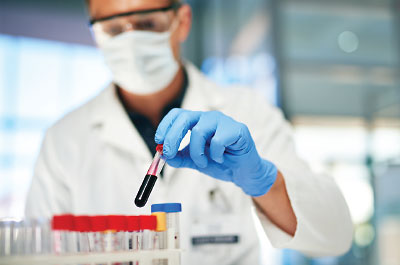New Developments in Blood-Based Biomarkers for TBI
Abstract
Aggregate data from a new test administered after a traumatic brain injury could lead to the prevention of persistent symptoms and new drug treatments.

The Centers for Disease Control and Prevention (CDC) has estimated that 1.5 million Americans survive various degrees of traumatic brain injury (TBI) every year. Although most TBI is characterized as mild, even less severe head injuries can have serious consequences that develop over time and can linger over months or years. A proper TBI diagnosis may not be made for multiple reasons, including patient hesitancy to undergo neuroimaging.
Earlier this year Abbot received FDA clearance for Abbott’s Alinity i TBI test, a commercially available blood test to evaluate patients in acute settings for concussion. The intent of this test is to screen patients who present with an acute head injury and quickly decide which patients require a CT scan of the brain. The belief is that the health care system could save money by avoiding unnecessary CT scans while patients avoid unwanted radiation exposure. At this time, there is no effective pharmacologic intervention for the vast majority of mild TBI cases, and this is a medical knowledge gap that needs to be filled. Nonetheless, there is a need to diagnose these patients so that they can be monitored in their recovery and placed on restricted activity to avoid repeated head trauma. If symptoms persist, further evaluation and possibly rehabilitation therapy may be initiated.
Upon first consideration, the test seems laudable and meaningful. Unfortunately, the implementation is complicated. In 2021, the FDA approved Abbott’s i-STAT TBI plasma test, a specialized handheld device. However, it is unclear whether Abbott’s first effort has moved the needle on the general approach to mild TBI assessment in the two years since.
The handheld instrument needed for Abbott’s i-STAT TBI Plasma test was expensive and not available in most hospitals. A CT scanner is already present and readily available in the acute care setting, making it easy for a physician to follow the path of least resistance and order a CT scan. A negative CT reassures the Emergency Department physician that there is no bleeding in the brain and the patient can be discharged.
Abbott believes the new Alinity i TBI test is a better option as it can be performed on the company’s Alinity i laboratory instrument, which is reported to be already available in hospitals across the country. This fact is critical, as the hospital won’t need to evaluate and purchase a new instrument. In addition, the new test measures whole blood, so samples do not have to be centrifuged to separate plasma from cells, saving precious minutes.
What biomarkers are being measured in this simple Alinity i TBI test blood test? In short, the test detects glial fibrillary acidic protein (GFAP) and ubiquitin C-terminal hydrolase L1 (UCH-L1), which are released by the brain into the peripheral blood when the brain is injured. There are numerous studies confirming the utility of these biomarkers if the head injury is evaluated within 12 to 24 hours. The Alinity i TBI test has a 96.7% sensitivity rate and a 99.4% negative predictive value rate, and it can provide results within 18 minutes, according to Abbott.
If the patient is examined in the local Emergency Department shortly after trauma, Abbott’s Alinity i TBI test can be performed. This would likely generate a valuable piece of data, even if the CT scan was still ordered. When present, the biomarkers measured by the blood test do not necessarily indicate which patients will improve spontaneously and which will experience chronic traumatic brain injury symptoms. Currently, there is no test that can predict the long-term outcome of head injury, and a positive blood test might suggest that follow-up care is indicated. Aggregation of data collected in Emergency Departments performing Abbott’s Alinity i TBI test presents a unique opportunity to compile a huge database.
The database alone may favor the implementation of Abbott’s Alinity i TBI test. While every test has some false positives and false negatives, over time meaningful results could emerge by amassing large numbers of data points on many patients. The current status of TBI research is stagnant, and this could be a way to move forward, particularly toward prevention of persistent symptoms via development of new drugs or repurposing of marketed medications.
Based on current recommendations, if patients are examined more than 24 hours after injury, the Abbott test is not useful. Although theoretically, the biomarker levels drop and the test results return to normal, we propose that important information could be gleaned by collecting key clinical data along with biomarker levels from a large number of patients seen at time points beyond 24 hours. This could have prognostic value in suggesting likelihood of lasting brain damage and could provide a means to assess new treatments so desperately needed to avert long-term consequences. These informative correlations may emerge only when thousands and tens of thousands of concussion patients are tested. Although patients with severe TBI are usually diagnosed and treated, a preponderance of mild injuries are unrecognized, and these people may return prematurely to activities that lead to repeated trauma, which is known to greatly magnify the risk of serious neurodegeneration and severe consequences.
Abbott’s Alinity i TBI blood test is designed to reduce unnecessary head CTs, but it could be so much more. By creating a relatively inexpensive and commercially available blood test for concussion, Abbott may have opened the door to a new phase of TBI evaluation. Large databases and electronic medical records make new inquiry possible to shed light on the inadequately studied field of mild TBI and post-concussion syndrome. ■



